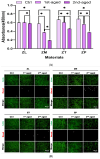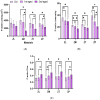Research of Optical Properties and Biocompatibility in Different Zones of Multilayered Translucent Zirconia on Hydrothermal Aging
- PMID: 39517464
- PMCID: PMC11547145
- DOI: 10.3390/ma17215189
Research of Optical Properties and Biocompatibility in Different Zones of Multilayered Translucent Zirconia on Hydrothermal Aging
Abstract
Objective: We assessed the changes in optical properties and biocompatibility of transition zones in multilayered translucent monolithic zirconia exposed to prolonged hydrothermal aging and compared the results to those with different yttrium oxide contents.
Materials and methods: Four types of zirconia blocks from IPS e.max ZirCAD were used: 3Y-TZP e.max ZirCAD LT (ZL), 4Y-TZP e.max ZirCAD MT (ZM), 5Y-TZP e.max ZirCAD MT Multi (ZT), and 3Y/5Y-TZP e.max ZirCAD Prime (ZP). A total of 120 specimens (15.0 mm diameter and 1.5 mm height) were fabricated and divided into three groups (n = 10). The aging process for the specimens was conducted in an autoclave set to 134 °C and 0.2 MPa, with durations of 0 h (control), 5 h (first aged), and 10 h (second aged). The optical properties and biocompatibility were analyzed, followed by a statistical analysis of the data (α = 0.05).
Results: Before and after aging, ZL and ZP exhibited the lowest color changes. ZT exhibited the highest average transmittance and translucency parameter values, while ZL had the lowest. The water contact angle test showed the highest value in ZM and lowest in ZL across all the aging stages. ZL, ZM, and ZP showed a considerable decrease in the water contact angle; however, ZT did not. A cell counting kit-8 assay showed ZL had the highest value, while ZM had the lowest. A filamentous actin test exhibited the highest value in ZL and lowest in ZM. In the vinculin analysis, ZL and ZT exhibited the lowest values, whereas ZM and ZP had the highest.
Conclusion: 3Y/5Y-TZP exhibited a balanced performance across critical parameters, such as color stability, translucency, and biocompatibility, aligning with 3Y-TZP. While 5Y-TZP demonstrated superior translucency, it confirmed the lowest color stability, whereas 3Y-TZP achieved the highest biocompatibility. These properties provide clinicians with a reliable material option that ensures superior esthetic outcomes and long-term prognosis, ultimately contributing to improved patient satisfaction and clinical longevity.
Keywords: biocompatibility; hydrothermal aging; optical property; surface property; yttrium oxide; zirconia.
Conflict of interest statement
The authors declare no conflicts of interest.
Figures






Similar articles
-
Changes in the Properties of Different Zones in Multilayered Translucent Zirconia Used in Monolithic Restorations During Aging Process.J Funct Biomater. 2025 Mar 10;16(3):96. doi: 10.3390/jfb16030096. J Funct Biomater. 2025. PMID: 40137375 Free PMC article.
-
Impact of hydrothermal aging on the light transmittance and flexural strength of colored yttria-stabilized zirconia materials of different formulations.J Prosthet Dent. 2021 Mar;125(3):518-526. doi: 10.1016/j.prosdent.2020.01.016. Epub 2020 Mar 19. J Prosthet Dent. 2021. PMID: 32199639
-
Comparison of the mechanical properties of translucent zirconia and lithium disilicate.J Prosthet Dent. 2018 Jul;120(1):132-137. doi: 10.1016/j.prosdent.2017.08.004. Epub 2018 Jan 6. J Prosthet Dent. 2018. PMID: 29310875
-
Effects of Aging on the Color and Translucency of Monolithic Translucent Y-TZP Ceramics: A Systematic Review and Meta-Analysis of In Vitro Studies.Biomed Res Int. 2021 Jan 25;2021:8875023. doi: 10.1155/2021/8875023. eCollection 2021. Biomed Res Int. 2021. PMID: 33575352 Free PMC article.
-
Ultra-translucent zirconia processing and aging effect on microstructural, optical, and mechanical properties.Dent Mater. 2022 Apr;38(4):587-600. doi: 10.1016/j.dental.2022.02.016. Epub 2022 Mar 7. Dent Mater. 2022. PMID: 35272865 Review.
References
Grants and funding
LinkOut - more resources
Full Text Sources

